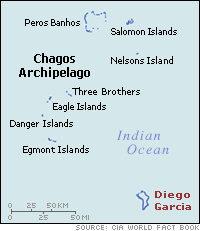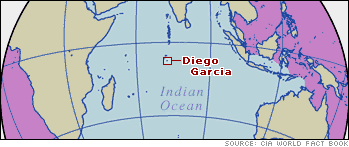Where in the World Is Diego Garcia?

A strategic U.K. and U.S. airbase with a dark history
by Borgna Brunner
 British Indian Ocean Territory, a dependency of the United Kingdom, includes Diego Garcia. Related Links |
Few could accuse you of ignorance for never having heard of Diego Garcia—much less for not knowing that it's not a person but an island. One of the most obscure and far-flung places on earth, Diego Garcia doesn't come tripping off the tongue of even the most geographically sophisticated.
There are times, however, when the U.S. military has considered this 17-square-mile atoll of coral and sand in the middle of the Indian Ocean one of the most valuable pieces of real estate on Earth.
A British Territory, Leased to the United States
The Portuguese explored Diego Garcia in the 1500s (it is named for a Portuguese navigator). Between 1814 and 1965 it was a territory of Mauritius. It then became part of the Chagos Archipelago, which belonged to the newly created British Indian Ocean Territory. In 1970, the island was leased to the United States, and developed as a joint U.S.-UK air and naval refueling and support station during the cold war. Located in the middle of the Indian Ocean and out of cyclone range, it was ideal for keeping an eye on the Soviet Union.
A Strategic Air Base
Diego Garcia proved to be critically important as a refueling base during the 1991 Persian Gulf War, and during Operation Desert Fox, it served as a base for B-52 bombers, which on Dec. 17, 1998, launched nearly 100 long-range cruise missiles aimed at Iraq. Beginning on Oct. 7, 2001, the United States again used Diego Garcia when it launched B-2 and B-52 bombers attacks against Afghanistan. In the current British and American-led war against Iraq, Diego Garcia has once again played a crucial strategic role.
The fact that Diego Garcia is more than 3,000 miles south of Iraq, and just a shade closer to Afghanistan, has not posed the logistical problems one might expect. According to the U.S. Air Force, B-52s have an "unrefueled combat range in excess of 8,800 miles."
The Military Base Today
In 2006, about 40 British and 1,000 U.S. military personnel, and 2,400 support workers of various nationalities (primarily Filipino and Sri Lankan) reside there. A number of al-Qaeda suspects are thought to be held and interrogated on the island (although the U.S. military will not confirm this), including Hambali (Riduan Isamuddin), the leader of the Asian terrorist group Jemaah Islamiyah, responsible for the 2002 terrorist bombing in Bali.

Forced Removal of the Indigenous Inhabitants
Although Diego Garcia once had a small native population, the inhabitants, known as the Ilois, or the Chagossians, were forced to relocate (1967-1973) so that the island could be turned into the U.S. military base. Most of the roughly 1,500 displaced Chagossians were agricultural workers and fisherman. Uprooted and robbed of their livelihood, the Chagossians now live in poverty in Mauritius's urban slums, more than 1,000 miles from their homeland. A smaller number were deported to the Seychelles. About 850 islanders forced off Diego Garcia are alive today, and another 4,300 Chagossians have been born in exile. A 2003 60 Minutes segment and a 2004 documentary by Australian journalist and filmmaker John Pilger, Stealing a Nation, have done much to publicize the little-known plight of the islanders.
The Chagossians' Search for Justice
The Chagossians have turned to the British courts to fight for the right to return to their homeland. In 2000, a British court ruled that the order to evacuate Diego Garcia's inhabitants was invalid, but the court also upheld the island's military status, which permits only personnel authorized by the military to inhabit the island. The Ilois also sued the British government for compensation, but in Oct. 2003 a British judge ruled that although the Chagossians had been treated "shamefully" by the government, their claims were unfounded.
A Further Setback
To further thwart the Chagossians' claims—and as a result of strong pressure from the U.S., which has cited security reasons for keeping the islanders from returning—the British government issued an "Order of Council" in 2004, prohibiting islanders from ever returning to Diego Garcia. This archaic, centuries-old royal prerogative permitted the Blair government to overrule the 2000 High court verdict.
Vindication
But in May 2006, the High Court in London ruled that the Chagossians may in fact return to other Chagossian islands, and offered a withering assessment of the British conduct in the case, calling it "outrageous, unlawful and a breach of accepted moral standards."
"The suggestion that a minister can, through an Order in Council, exile a whole population from a British Overseas Territory and claim he is doing so for the 'peace, order and good government' of the Territory is repugnant."
American Resistance
The Chagossians have accepted that they cannot return to Diego Garcia because of the U.S. airbase, but this new verdict paves the way for the islanders to move elsewhere in the Chagos archipelago, to the Salomon islands and Peros Banhos, which are more than 100 miles from Diego Garcia. The U.S., however, is opposed to anyone other than military personnel and their employees living anywhere in the Chagos archipelago, asserting that security will be compromised. According to a State Department official, Lincoln Bloomfield Jr., allowing civilians in the archipelago could potentially lead to "terrorists infiltrating the islands." Having finally triumphed in a hard-won and lengthy legal battle, the Chagossians now find themselves at loggerheads with the world's superpower.







